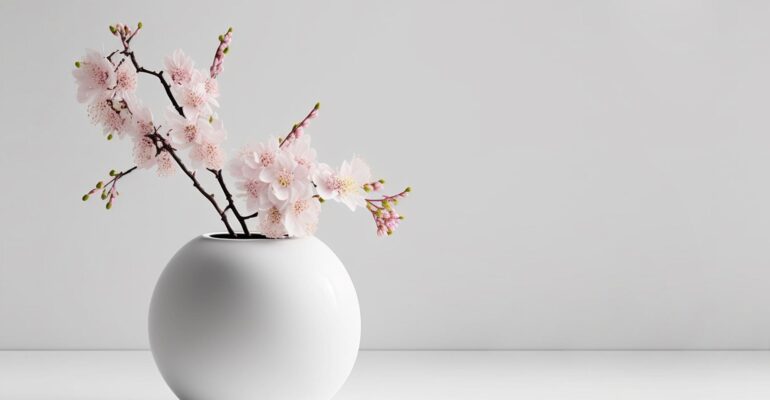The Meditative Power of Ikebana: Finding Calm Through Flower Arranging
The Meditative Power of Ikebana: Finding Calm Through Flower Arranging
In today’s fast-paced world, it can be a challenge to carve out moments of calm and stillness. We’re constantly bombarded by information, distracted by technology, and running from one task to the next. But what if there were an art form that could help us slow down, reconnect with nature, and find a sense of mindfulness? Enter Ikebana, the traditional Japanese art of flower arranging, which is not only about creating visually striking arrangements but also about finding inner peace through the process itself.
Ikebana has long been cherished as more than just a method of arranging flowers; it’s a practice that embodies meditation, simplicity, and the beauty of imperfection. By focusing on natural elements, balance, and the quiet elegance of minimalism, Ikebana offers a way to cultivate mindfulness in a world filled with noise.
A Brief History and Philosophy of Meditative Power of Ikebana
Ikebana, also known as “the way of flowers” or kado, has roots that trace back to the 7th century. It originally began as a form of religious offering in Buddhist temples, where practitioners would arrange flowers in honor of Buddha. Over time, however, it evolved into a distinct art form that transcended its religious origins, becoming a cultural expression of aesthetic principles like harmony, balance, and simplicity.
Unlike typical Western floral arrangements that often emphasize abundance, bright colors, and symmetry, Ikebana is much more focused on minimalism and balance. In an Ikebana arrangement, every stem, leaf, and flower is placed with intention, reflecting the interplay between nature and the human hand. It’s not just about beauty on the surface; it’s about a deeper connection between the artist, the arrangement, and the surrounding environment.
One of the core philosophies of Ikebana is the concept of wabi-sabi, the appreciation of imperfection and transience. Wabi-sabi teaches us that beauty can be found in the incomplete, the aged, and the imperfect—much like life itself. In Ikebana, this translates to an understanding that not every flower must be perfect, and not every branch needs to be in full bloom. The natural imperfections of the plants are part of what makes the arrangement truly beautiful.
Ikebana as a Meditative Practice
Practicing Ikebana is not just about arranging flowers—it’s a form of meditation. It requires you to slow down, become mindful of the natural elements in front of you, and connect with the process. Unlike many other art forms, Ikebana places equal importance on what is left out as what is included. The empty spaces between the flowers (called **ma**) are just as important as the blooms themselves. It teaches you to appreciate silence, emptiness, and the subtle flow of nature.
When you practice Ikebana, you are encouraged to focus fully on the present moment. Your attention is directed towards the shape of the stems, the colors of the leaves, and the way the arrangement interacts with its environment. In this sense, it’s much like traditional mindfulness meditation, where the goal is to remain aware of the current moment, free of distractions.
Additionally, the physical act of creating an Ikebana arrangement—choosing the materials, trimming the branches, carefully placing each element—can have a grounding effect, allowing the mind to relax and settle into a flow state. The process itself becomes an exercise in patience and presence, where each decision, each cut of a stem, is made with mindfulness.
How to Create a Basic Ikebana Arrangement: A Step-by-Step Guide
You don’t have to be an expert florist to start practicing Ikebana. In fact, its simplicity is what makes it accessible to anyone, regardless of experience level. Here’s a basic guide to get started with your own arrangement:
Materials You’ll Need:
– A shallow vase or bowl (a kenzan, or spiky metal base, is often used to hold the stems in place, but you can use floral foam if you don’t have one).
– A few stems of flowers (less is more here—think about using just three or four).
– Some branches or leaves to add structure.
– Scissors or floral shears.
Steps:
1. Choose Your Flowers and Branches:
– For your first arrangement, start with three main elements: one tall branch, a medium flower, and a smaller bloom or leaf. This will give your arrangement the balance it needs while keeping things simple.
2. Prepare the Vase:
– Fill your vase or bowl with water and place the kenzan at the bottom. This will serve as the base for holding your flowers and branches upright.
3. Start with the Tallest Branch:
– Place the tallest branch first, slightly off-center, so that it reaches upwards at a diagonal angle. This is often referred to as the “heaven” element in Ikebana and represents the sky or spiritual plane.
4. Add the Medium Flower:
– The second element is typically a medium-sized flower that balances the height of the branch but doesn’t overpower it. This is placed lower and at a different angle, representing the “human” element.
5. Place the Smaller Flower or Leaf:
– Lastly, add a smaller flower or leaf near the base. This is the “earth” element and completes the arrangement, grounding the taller elements while creating visual harmony.
6. Adjust and Refine:
– Take a step back and examine your arrangement. The key to Ikebana is asymmetry—so don’t be afraid to leave empty spaces or allow the branches to bend in natural, unpredictable ways. You can trim or rearrange as needed, but remember: simplicity is your friend!
7. Final Touches:
– Once you’re happy with the placement of your elements, your Ikebana arrangement is complete. Place it somewhere quiet where you can appreciate its simplicity and the sense of calm it brings.
Ikebana and the Aesthetic of Wabi-Sabi
The philosophy of wabi-sabi, central to many traditional Japanese arts, is one of the key aesthetic principles that Ikebana reflects. Wabi-sabi is about finding beauty in the imperfect, the impermanent, and the incomplete. It embraces the flaws and imperfections that naturally arise in both life and art.
In Ikebana, this can be seen in the use of branches that may be crooked, flowers that may not be in full bloom, or leaves that are slightly weathered. Instead of striving for a perfect, symmetrical arrangement, Ikebana encourages us to celebrate these imperfections, acknowledging that they are part of the beauty of nature.
This aesthetic is a refreshing antidote to the perfectionism and pressure that often dominate modern life. Ikebana reminds us that there is no need to control every detail or strive for flawless results. The irregularities and asymmetries are not only accepted but celebrated as part of the art itself.
Bringing Ikebana Into Your Life
Whether you’re an experienced gardener or have never arranged a flower in your life, Ikebana is a practice that anyone can incorporate into their daily routine. It’s not about having the most beautiful or elaborate arrangement, but about the process of slowing down, becoming mindful, and connecting with nature in a meaningful way.
By practicing Ikebana, you invite a sense of calm into your space and mind. The simple act of arranging flowers can become a daily meditation, a reminder to appreciate the beauty of simplicity and imperfection.
So, why not give it a try? The next time you find yourself feeling overwhelmed or distracted, take a few minutes to step outside, pick a few flowers or branches, and create your own Ikebana arrangement. You might just find that the process leaves you feeling more centered, calm, and in tune with the world around you.
Final Thought of Ikebana
Ikebana, like many traditional Japanese arts, offers us lessons that go beyond the surface. It’s not just about aesthetics, but about the mindfulness and intention behind each arrangement. In a world that often values speed and perfection, Ikebana reminds us that beauty can be found in simplicity, and that calm can be found in the most unexpected places—like a single, imperfect flower.











